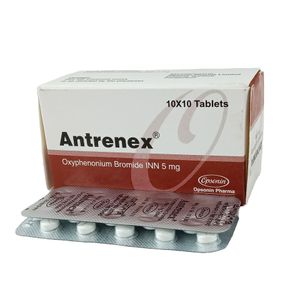Antrenex Uses, Dosage, Side Effects and more
Antrenex is an anticholinergic drug, a medication that reduces the effect of acetylcholine, a chemical released from nerves that stimulates muscles, by blocking the receptors for acetylcholine on smooth muscle (a type of muscle). It also has a direct relaxing effect on smooth muscle. Antrenex is used to treat or prevent spasm in the muscles of the gastrointestinal tract in the irritable bowel syndrome. In addition, Antrenex inhibits gastrointestinal propulsive motility and decreases gastric acid secretion and controls excessive pharyngeal, tracheal and bronchial secretions.

| Attribute | Details |
|---|---|
| Trade Name | Antrenex |
| Generic | Oxyphenonium |
| Oxyphenonium Other Names | Oxyphenonium ion |
| Weight | 1%, 5mg, |
| Type | Eye Drops, Tablet |
| Formula | C21H34NO3 |
| Weight | Average: 348.4996 Monoisotopic: 348.253868959 |
| Protein binding | 93% bound to albumin |
| Groups | Approved |
| Therapeutic Class | Anticholinergics (antimuscarinics)/ Anti-spasmodics |
| Manufacturer | Opso Saline Ltd, Opsonin Pharma Ltd |
| Available Country | Bangladesh, |
| Last Updated: | January 7, 2025 at 1:49 am |
Uses
Abdominal pain, Colic, Gastrointestinal tract spasm, Peptic ulcer disease, Visceral spasms
How Antrenex works
Action is achieved via a dual mechanism: (1) a specific anticholinergic effect (antimuscarinic) at the acetylcholine-receptor sites and (2) a direct effect upon smooth muscle (musculotropic).
Dosage
Adult: 1-2 tablets 3-4 times daily
Children: ½ to 1 tablets 1-3 times daily
Side Effects
Dryness of mouth, difficulty in talking/swallowing; reduced bronchial secretions; blurring of vision, photophobia; bradycardia followed by tachycardia and arrhythmias; urinary retention, constipation, vomiting, nausea; confusion and giddiness.
Precaution
Children; elderly; benign prostatic hyperplasia; acute MI, cardiac failure, hypertension, thyrotoxicosis; pregnancy and lactation; fever; angle-closure glaucoma.
Interaction
Reduced gastric motility interferes with absorption of other drugs. Effects potentiated by other antimuscarinics including amantadine, some antihistamines, phenothiazines and TCA.
Pregnancy & Breastfeeding use
Category C: Either studies in animals have revealed adverse effects on the foetus (teratogenic or embryocidal or other) and there are no controlled studies in women or studies in women and animals are not available. Drugs should be given only if the potential benefit justifies the potential risk to the foetus.
Contraindication
Urinary outflow obstruction, paralytic ileus, myasthenia gravis.



